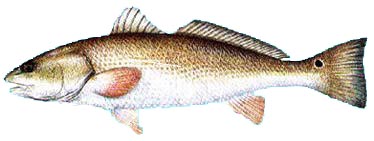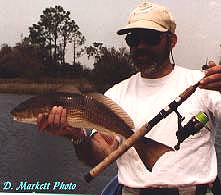The Redfish

By Buck Davidson
Early morning, inland Gulf of Mexico:
The last misty remnants of the pre-dawn fog cling to the water, as the mirror smooth surface reflects a postcard-perfect sunrise. The only sound is the occasional crunch of your guide's push pole contacting oysters in the soft mud of the marsh. As you stand on the forward casting platform of the flats boat, you forget fishing for a moment and allow your senses to be overwhelmed by the awesome natural beauty of the mangrove forest. Your attention is jolted from the tranquil scene by the sound of your guide's voice from atop the platform: "Fish coming, two o'clock - about 50 yards out." You snap your head to the right, noting that the glassy surface of the water now is decidedly wrinkled. The source of the wrinkle is five small wakes moving toward your boat, each pushing a bulge of water ahead of it. The fish are moving slowly onto the bar, so you take a moment to ready the nine-foot fly rod and compose yourself. With the fish in range and your adrenaline at a manageable level, you drop a small shrimp fly two feet ahead of the lead fish. You barely have time for one twitch before the water erupts as you set the hook. You catch a brief glimpse of a bronze-colored tail as line hisses from your fly reel. Your guide poles frantically toward the fleeing fish as you try to regain line from what is the undisputed powerhouse among Suncoast inshore species: the redfish.
shrimp fly two feet ahead of the lead fish. You barely have time for one twitch before the water erupts as you set the hook. You catch a brief glimpse of a bronze-colored tail as line hisses from your fly reel. Your guide poles frantically toward the fleeing fish as you try to regain line from what is the undisputed powerhouse among Suncoast inshore species: the redfish.
Redfish, which are also called red drum, reds and channel bass, range from Texas to Massachusetts. They are most prevalent in the Gulf of Mexico, but the larger fifty-plus pound individuals occur off the coast of North Carolina. Here on the Suncoast, a twenty pound red is considered braggin' size, but much larger ones are regularly caught. The red drum is a beautiful fish, especially in the winter. During the colder months they take on a bronze coloration with highlights of blue scattered around the body. The rest of the year they are more silver in color, but their copper-colored back remains virtually year-round. Redfish usually have spots along their body, especially near the tail. I say usually because I have seen as few as zero and as many as 18 spots on a redfish. Sometimes there will be several spots on one side and none on the other. Why? I don't know the answer to that one. If someone does I'd love to know myself. A close look at a Redfish's anatomy will say a lot about it's feeding habits. The mouth is positioned so as to face downward when open. This is well suited to the red's preferred feeding style, which consists of grubbing about the mud flats looking for shrimp, crabs and small fish. Redfish prefer the waters covering oyster bars, often moving into areas so shallow their tails stick out of the water as they feed. Knowledgeable anglers will look for "tailing" redfish on the flats during calm weather. A tailing redfish is a feeding redfish, and can be caught with a stealthy approach and careful bait presentation. Redfish are often skittish in very shallow areas, so minimize noise and make as long a cast as possible. The bait must land near the fish, since the water is often murky and visibility is minimal.
There are several methods to catching redfish, and they of course vary with the seasons and weather conditions. When chasing tailing reds, a favorite trick is to pole the boat close, then anchor and wade toward the feeding fish. A wading angler casts a lower profile than does one standing on a boat, so you can get much closer without being spotted. Important safety tip: wear shoes!! Trust me on this, oysters can slice your feet to ribbons. Redfish will find an area of deeper water near an oyster bar and stay there during much of the day. They come onto the flats to feed, usually during low tide. Watch for those tails. Dropping a bait into those areas of deeper water may pay off as well, since most reds are only too happy to gobble a food critter dumb enough to wander within eating distance. Good live baits include: shrimp, small crabs and sardines. Artificials are widely used for reds, with jigs, gold spoons and small plugs being the best. Careful with those multi-hooked plugs, though, since it's easy to get snagged in the oysters. Fly anglers in a mood for a fight will find a formidable foe in the redfish. Though they are not speed demons, they put up a strong, determined, head-shaking fight on light tackle. Reds don't waste their energy by jumping, preferring instead to slug it out below. They also have this habit of rubbing your line against those razor-sharp oysters I warned you about, so use a short section of 20-30 pound leader, 12-18 inches should be fine. Flats fishing for reds, as does all sight-fishing, demands a good pair of sunglasses. Not only do they cut down the glare and harmful UV rays, but you'll see fish you never would have otherwise.
That's a look at the redfish, one of the great success stories of fisheries management policies. Sorry I ran a little long this time, but these fellas are one of my favorites. More redfish stories coming, I promise - stay online and keep checking back from time to time. Until then, get out and catch 'em, keep what you can use, release the rest and save some for me. The bag and size limit changes occasionally, so be sure to check them before you go fishing (click here).
See you on the water.
Buck
Back to Game Fish Index


